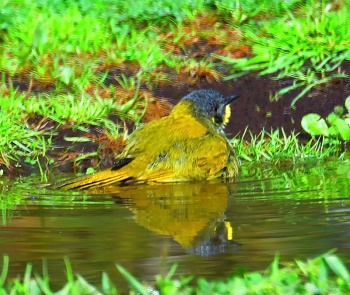m |
(Attempt to disguise copied text. Picture showing upperparts. References. Incomplete gone) |
||
| Line 1: | Line 1: | ||
| − | + | [[Image:1421IMG00590bcb.jpg|thumb|550px|right|Photo by {{user|Julien|Julien}}<br/>Near Mt Wellington, [[Tasmania]], May 2005]] | |
| − | [[Image:1421IMG00590bcb.jpg|thumb|550px|right|Photo by {{user|Julien|Julien}}<br/>Near Mt Wellington, [[Tasmania]]]] | ||
;[[:Category:Nesoptilotis|Nesoptilotis]] flavicollis | ;[[:Category:Nesoptilotis|Nesoptilotis]] flavicollis | ||
==Identification== | ==Identification== | ||
| − | Bright olive green | + | [[Image:Filtered D6L 1254 - Copy .JPG|thumb|350px|right|Photo by {{user|jweeyh|jweeyh}}<br />[[Tasmania]], [[Australia]], May 2017]] |
| + | Male 20–23 cm (7¾-9 in); female 18–20 cm (7-7¾ in) | ||
| + | *Bright olive green upperparts | ||
| + | *Dark silvery-grey head, neck and underparts | ||
| + | *Yellow throat bordered by a narrow black band | ||
| + | *Yellow chin | ||
| + | *Small yellow ear-patch | ||
| + | *Wing feathers outlined with yellow | ||
| + | *Black bill | ||
| + | *Reddish-brown eye<br /> | ||
| + | Females are smaller than males.<br /> | ||
| + | Young birds are very similar to adults, but duller overall. | ||
==Distribution== | ==Distribution== | ||
| Line 14: | Line 24: | ||
==Habitat== | ==Habitat== | ||
| − | + | Dry and wet forests, dominated by eucalyptus woodlands, sub-alpine forests, temperate rainforest, wet scrubs and coastal heathlands, parks, gardens, reserves in urban areas and orchards. | |
==Behaviour== | ==Behaviour== | ||
| − | The diet | + | ====Diet==== |
| − | + | The diet consists of arthropods, insects and spiders; nectar, fruit and most likely seeds too. They feed at all levels from the canopy down, but not often on the ground. | |
| − | The female | + | ====Breeding==== |
| + | The female constucts the small, cup-shaped nest from closely woven grass, bark and spider-web. It is lined with mammal fur or hair and placed close to the ground in dense shrubs. She incubates the eggs and also feeds the young. | ||
| + | The nests are parasitised by both [[Pallid Cuckoo]] and [[Fan-tailed Cuckoo]]. | ||
| + | ==References== | ||
| + | #{{Ref-Clements6thAug16}}#Handbook of the Birds of the World Alive (retrieved June 2017) | ||
| + | #Birds in Backyards | ||
| + | {{ref}} | ||
==External Links== | ==External Links== | ||
{{GSearch|Honeyeater+flavicollis}} | {{GSearch|Honeyeater+flavicollis}} | ||
[[Category:Birds]] [[Category:Nesoptilotis]] | [[Category:Birds]] [[Category:Nesoptilotis]] | ||
Revision as of 23:40, 2 July 2017
- Nesoptilotis flavicollis
Identification
Male 20–23 cm (7¾-9 in); female 18–20 cm (7-7¾ in)
- Bright olive green upperparts
- Dark silvery-grey head, neck and underparts
- Yellow throat bordered by a narrow black band
- Yellow chin
- Small yellow ear-patch
- Wing feathers outlined with yellow
- Black bill
- Reddish-brown eye
Females are smaller than males.
Young birds are very similar to adults, but duller overall.
Distribution
Endemic to Tasmania
Taxonomy
This is a monotypic species.
Formerly placed in the genus Lichenostomus.
Habitat
Dry and wet forests, dominated by eucalyptus woodlands, sub-alpine forests, temperate rainforest, wet scrubs and coastal heathlands, parks, gardens, reserves in urban areas and orchards.
Behaviour
Diet
The diet consists of arthropods, insects and spiders; nectar, fruit and most likely seeds too. They feed at all levels from the canopy down, but not often on the ground.
Breeding
The female constucts the small, cup-shaped nest from closely woven grass, bark and spider-web. It is lined with mammal fur or hair and placed close to the ground in dense shrubs. She incubates the eggs and also feeds the young.
The nests are parasitised by both Pallid Cuckoo and Fan-tailed Cuckoo.
References
- Clements, J. F., T. S. Schulenberg, M. J. Iliff, D. Roberson, T. A. Fredericks, B. L. Sullivan, and C. L. Wood. 2016. The eBird/Clements checklist of birds of the world: v2016, with updates to August 2016. Downloaded from http://www.birds.cornell.edu/clementschecklist/download/
- Handbook of the Birds of the World Alive (retrieved June 2017)
- Birds in Backyards
Recommended Citation
- BirdForum Opus contributors. (2024) Yellow-throated Honeyeater. In: BirdForum, the forum for wild birds and birding. Retrieved 27 April 2024 from https://www.birdforum.net/opus/Yellow-throated_Honeyeater





